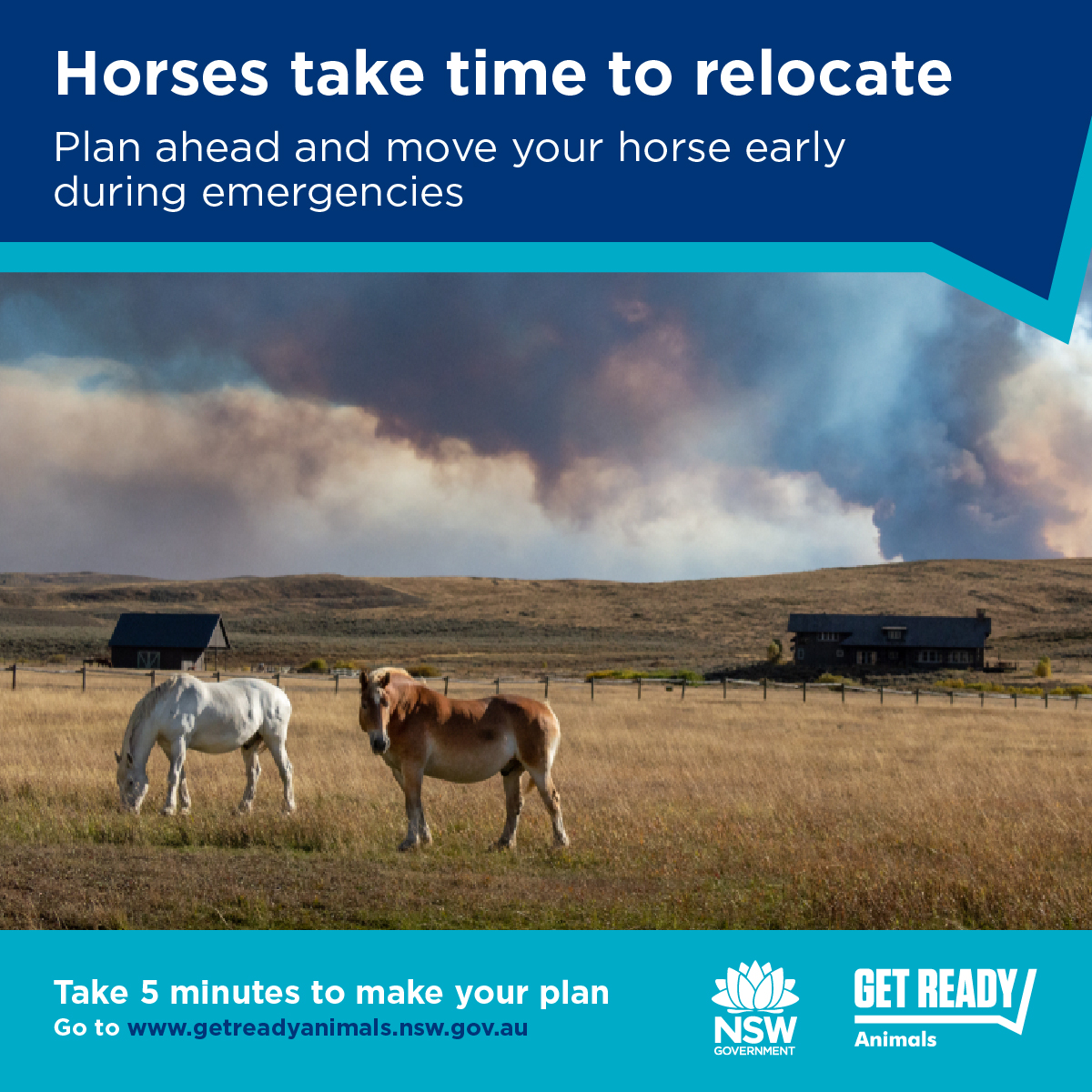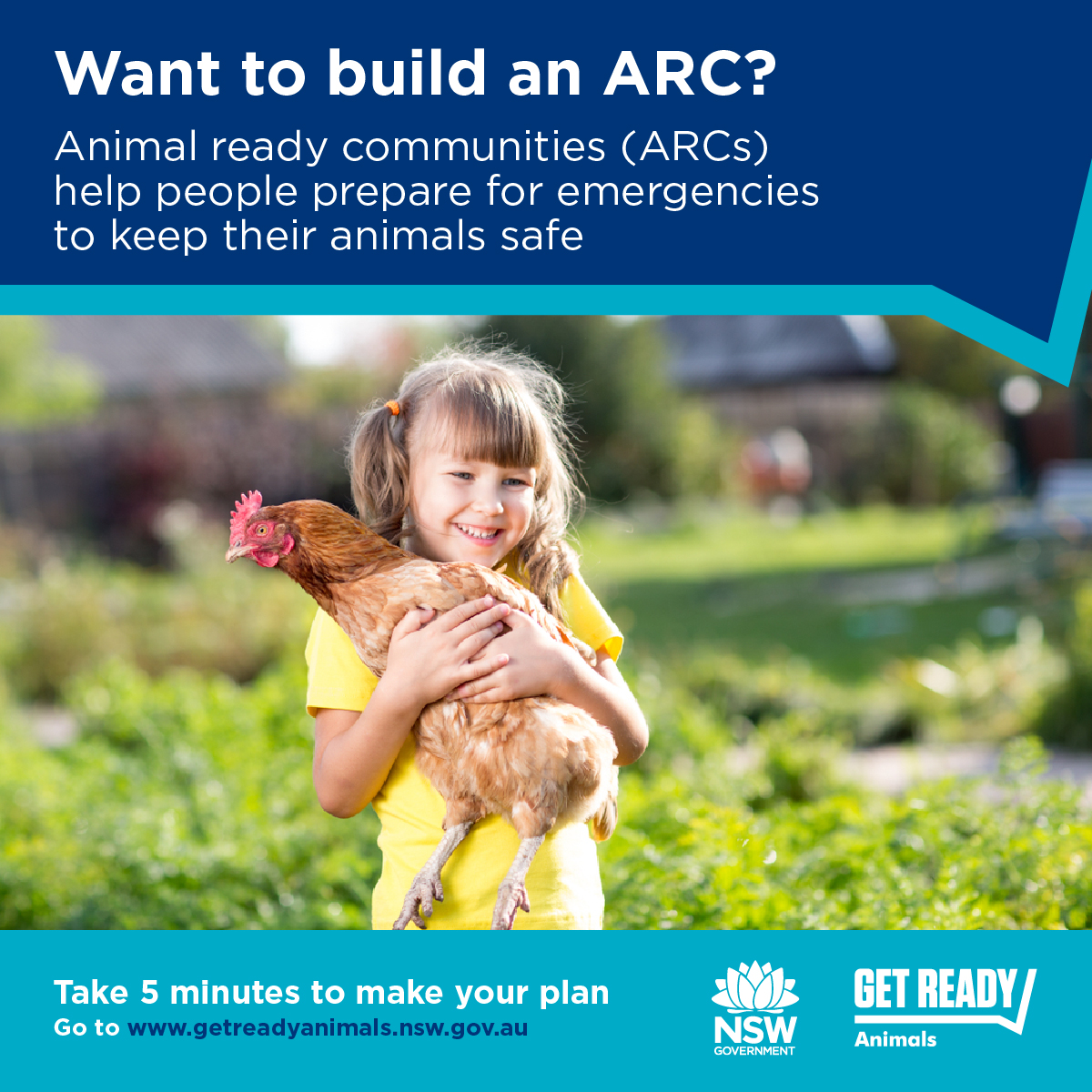

Emergencies such as floods or bushfires can happen quickly.
Planning how to take care of your animals before an emergency helps to keep everyone safe.
Let's Get Ready and Make an Animal Emergency Plan
Emergency Information
If you find wildlife impacted during emergencies, please contact your closest licensed wildlife rescue group. Download the IFAW Wildlife Rescue app to be connected at the touch of a button.
Having large animals and large numbers of animals on property requires special consideration and planning in advance of an emergency to ensure their safety and survival. Large animals/livestock can include horses, cattle, alpacas, goats, sheep and pigs.
Before creating your plan, you should:

WHEN will I leave?
Relocating large animals takes time, so it is best to move them early.
WHERE will I take my animals?
Have a list of multiple properties in different areas where you can relocate your animals to safety. It is best to talk to these property owners in advance of an emergency. Consider agistment properties that can take your animals for the short term, in case you need to re-build fences before returning them home.
HOW will I take my animals?
Consider suitable transport to move your animals such as a float or trailer. Check the equipment is safe to carry your animals, e.g. solid floor, tyres and roadworthy. Plan in advance who could move your animals for you if you are not at home, e.g. neighbour, friend, family, someone from your pony club, riding group etc. Read a factsheet about creating good NEIGHbour networks.
For more information on the movement of livestock and horses in an emergency, contact your Local Lands Service office.
WHAT do I need to prepare/take for my animal?
If your animal is on an agistment property, it is important that you have shared your emergency plan with the property owner.
Practice your plan
Like people, animals can behave differently under stress so practicing your plan helps you and your animals to:
If you are unable to relocate your animals off your property, it is important that you prepare a safe area onsite to give your animals the best chance of survival:
Other tips:
Around 63% of households in Australia have a pet. Pets are considered part of the family. Because of the close bonds people have with their pets, research shows that people do risky things in an emergency because of their pets such as:
Preparing your pets and small animals in advance of an emergency will reduce the level of risk and stress for you and your animals.

WHEN will I leave?
WHERE will I take my animals?
Plan for where you can stay during an emergency, such as with family or friends. If your animals can’t come with you, consider options such as boarding facilities. Ensure you have up to date vaccination papers and contact details for your options ahead of time.
You can also consider pet-friendly accommodation for you and your animals. Look for temporary rentals, caravan parks, or motels that accept pets.
Having a plan that provides you with a range of options for your family and animals, can reduce stress during an emergency.
During an emergency, evacuation centres may be opened to provide emergency support for you and your animals. You are responsible for the welfare of your animals at these sites, so make sure you have your animal “Grab & Go” bag with you. Remember, these sites may not always be available or suitable for the needs of your animals so other options are essential.
HOW will I get to my safe place?
Consider how you will transport your animals and which routes you will take.
Practice your plan to see how long it takes to get there, for example will you need to make more than one trip or need any help from neighbours or friends? It is important to understand your local evacuation routes and follow advice.
WHAT do I need to prepare/take for my animals?
Equipment
Having equipment ready to contain and move your animals easily is invaluable. Remember whatever you use should allow them to breathe, not cause injury or escape. Items can include:
Pack 3-7 days’ worth of supplies in a “Grab & Go” bag to care for your animals’ health and comfort and store for easy transport e.g. back-pack or plastic tub. Add items you will need BUT also those you might need, including:
Regularly check your supplies are not out of date. Water should be replaced every six months.
Identification for your pet is important in case they are separated from you during an emergency.
Practice your plan with your animals
Like people, animals can behave differently under stress so practicing your plan helps you and your animal. Practicing your plan can also alert you to any potential issues.
By including your animals, they will become more comfortable with containment, travelling and being around other animals and people. Reward them so it becomes a positive experience and easier during an emergency.
Animal holding facilities such as boarding, training, day care and breeding facilities can be particularly vulnerable during emergencies. They often have large number of animals in their care and are in rural or bush settings.
Having a plan, and practicing it regularly, is critical to ensure the animals in the care of these facilities are safe in a range of emergency situations.
The Planning for Emergencies - A Guide for Animal Holding Establishments - NSW DPI is a comprehensive guide that can assist with planning.
Some factors to consider when making your plan:
Here are some important sources of information to assist during an emergency.
Evacuation centres may be opened during an emergency to support you and your animals. In some emergencies Animal Safe Places may also be opened for the safety of your animals. You are responsible for the welfare of your animals, so make sure you have your animal “Grab & Go” bag with you. Remember, these sites may not always be available or suitable for the needs of your animal, so other options are essential.
If you are separated from your animals during an emergency, some options include:
Find information here on treating burned animals - Australian Veterinary Association - Animals and Natural Disasters
Visit Helping wildlife in emergencies, if you find wildlife that requires assistance.
Not being at home when an emergency occurs can happen. Getting home may also be impossible due to road or bridge closures. Your plan should cover this risk. Don’t wait for an emergency to give instructions as phone lines could be down or jammed.
These resources have been developed to help community groups, schools, breed clubs, rescue groups, and businesses plan for animals in emergencies.
Resources include emergency plans templates and guidelines, handouts, newsletter articles, social media tiles, children’s activities and community resilience fact sheets
Here are some ideas to help encourage others to prepare:
Below are a range of videos to help you prepare for your animals’ safety in an emergency.
A range of social media tiles are freely available to use and to encourage planning and preparedness. They are excellent resources to share with your family, friends, through your organisation, business, and in your community.
When you share, don't forget to use the hashtag #GetReadyAnimals
Horses take time to relocate. Plan ahead and move your horse early during emergencies.
Download ImageAnimals can be at serious risk during an emergency. contain your animals ASAP to ensure they are close at hand when you leave.
Download ImageAnimals can be at serious risk during an emergency. Contain your animals ASAP to ensure they are close at hand when you leave.
Download ImageHow will you contain and transport your pet during an emergency? Crates and carriers keep pets safe and easily transportable.
Download ImageHow will you contain and transport your pets during and emergency? Crates and carriers keep pets safe and easy to transport in emergencies.
Download ImageYou can bring your animals to an Evacuation Centre. Don't forget to pack their Grab and Go Bag, so you can look after them.
Download ImageHorses take time to relocate. Plan ahead and move your horse early during emergencies.
Download ImageEmergencies can quickly threaten the safety of your animals. Relocate large numbers of animals early.
Download ImageHave you got a good NEIGHbour? Share your emergency plan with someone so they know what you intend to do.
Download ImageWant to build an ARC? Animal ready communities (ARCs) help people prepare for emergencies to keep their animals safe.
Download ImageResponsible for multiple animals? Learn how to plan for emergencies at www.getreadyanimals.nsw.gov.au
Download ImageDuring emergencies your pets can become separated from you. Use identification tags and collars, microchips and register at www.petregistry.nsw.gov.au
Download ImageWhen will you go with your animals during an emergency? Staying with family or friends is often the most comfortable and convenient option.
Download ImageResponsible for multiple animals? Learn how to plan for emergencies at www.getready.nsw.gov.au
Download ImageGet Ready Animals. Resources to help children plan for their animals in emergencies www.getreadyanimals.nsw.gov.au
Download ImageGet Ready Animals. Resources to help children plan for their animals in emergencies www.getreadyanimals.nsw.gov.au
Download Image














